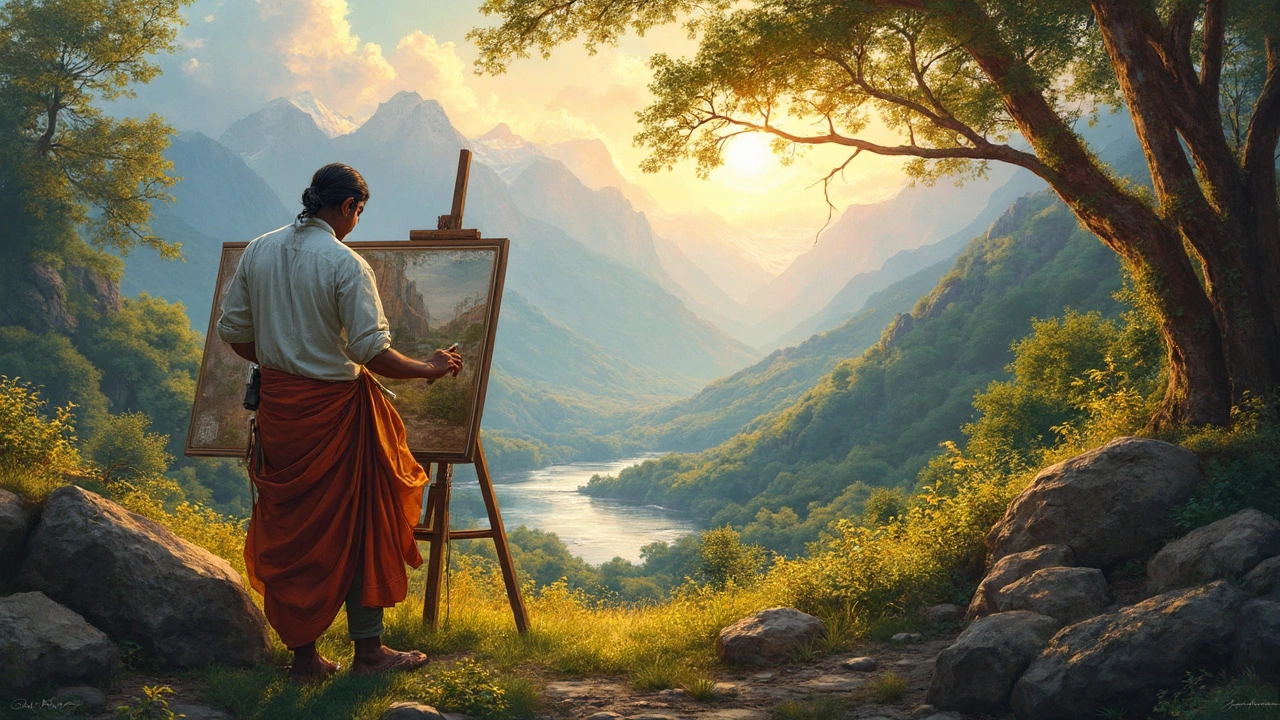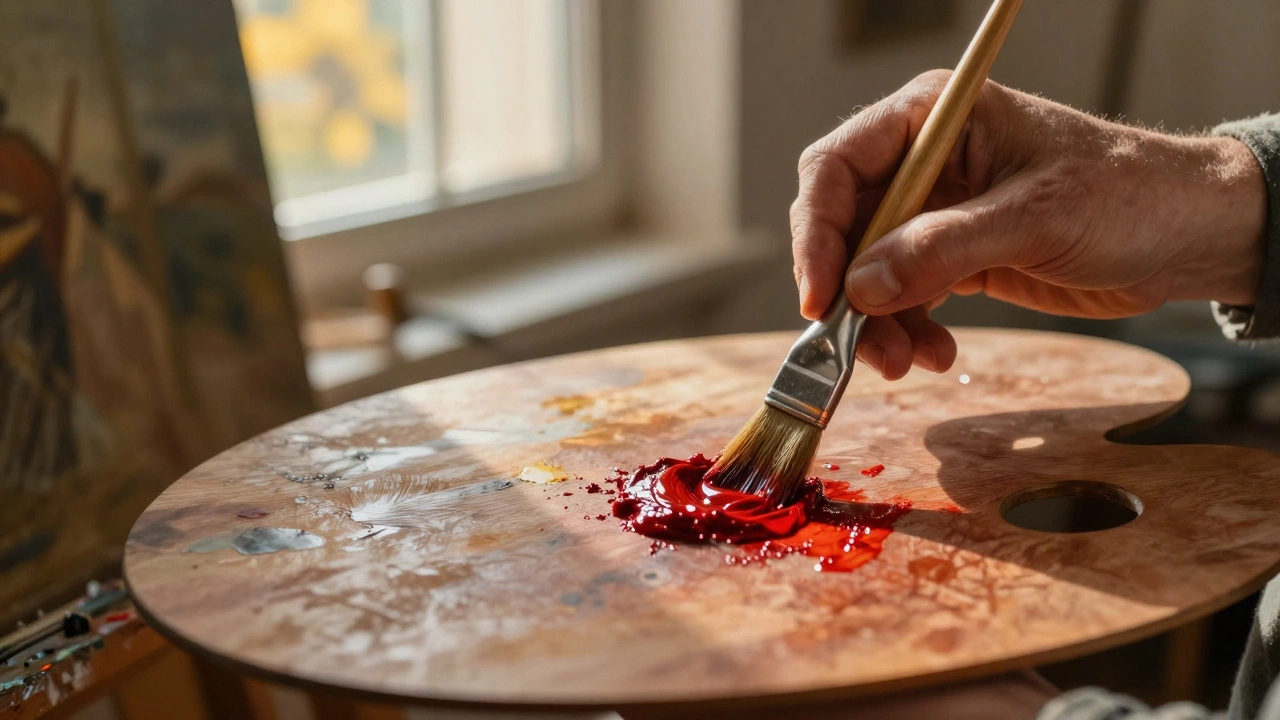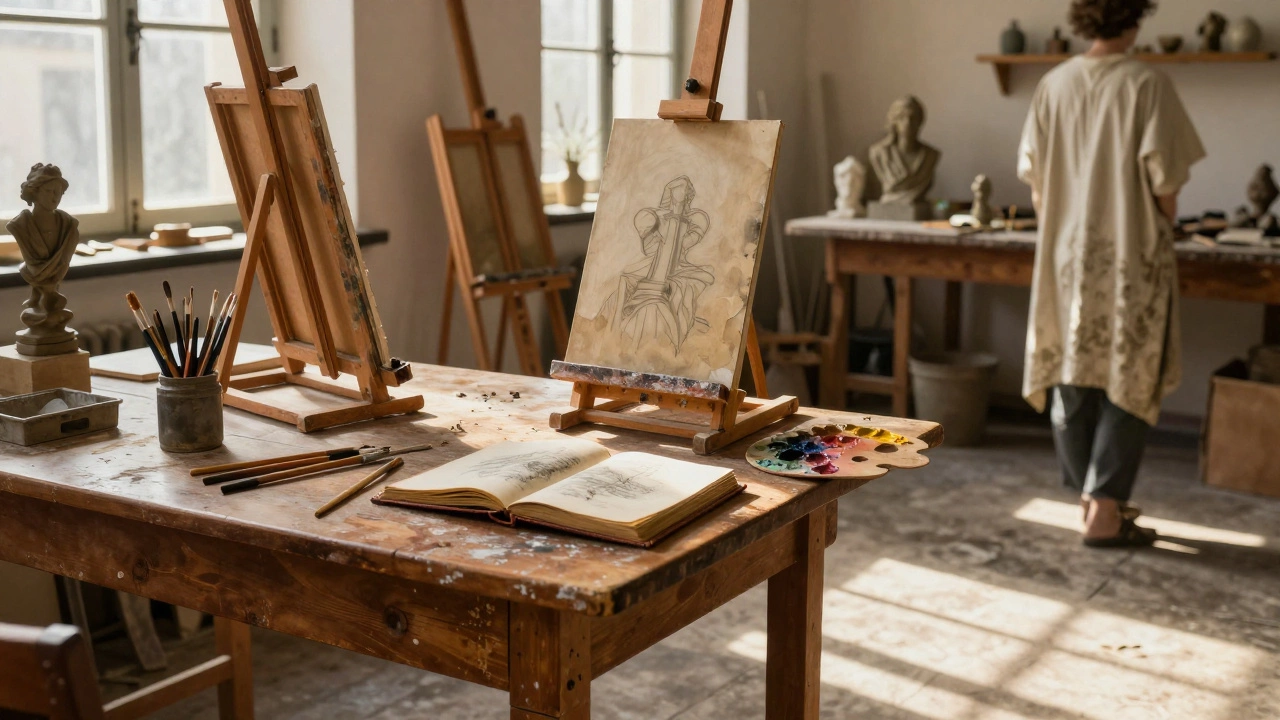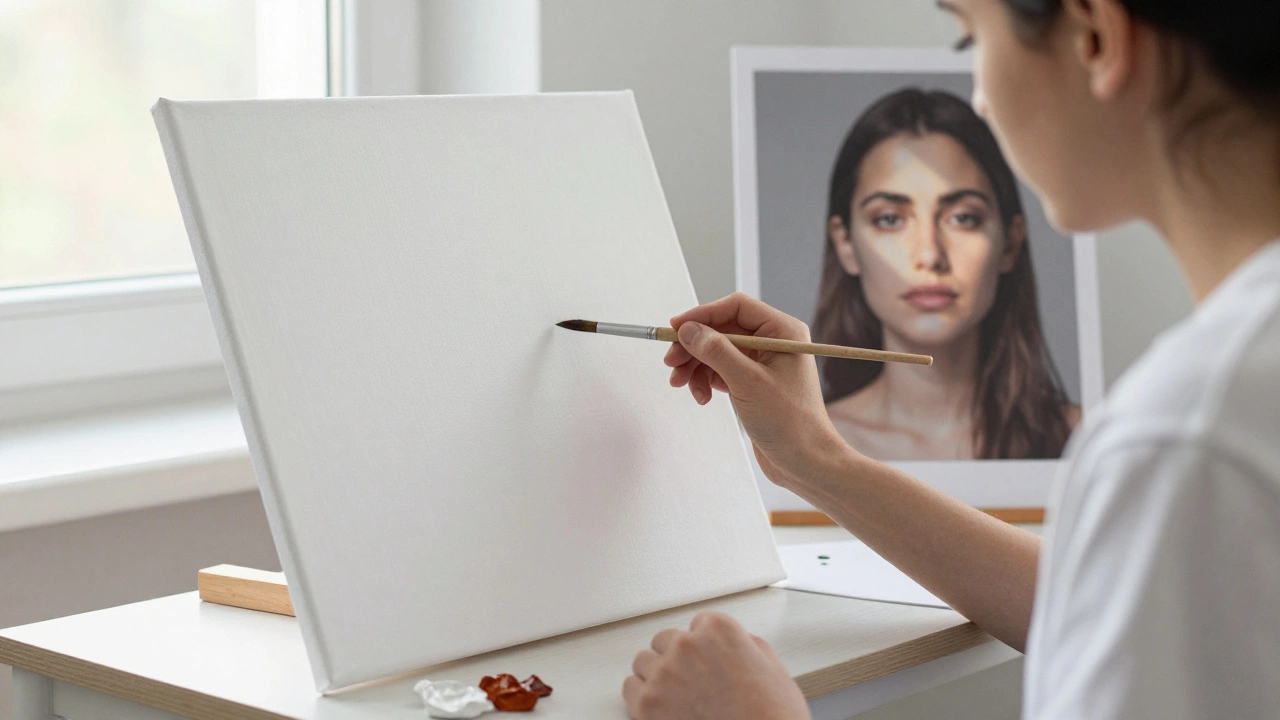Modern landscape painting might seem like a natural evolution in the art world now, but there was a time when it was groundbreaking, even controversial. This shift wasn't just about changing what was on the canvas—it was about changing how artists saw and represented the world around them.
Imagine walking into an art gallery back in the mid-1800s. You'd primarily see neat, detailed depictions of historical events or religious themes. Landscapes were typically idealized, almost like picture-perfect postcards. Then came a rebel who saw things differently. Instead of painting what he thought landscapes should look like, he strived to capture what they felt like. This was something entirely new and, believe it or not, it changed everything.
His name? Claude Monet. He didn't just paint landscapes; he transformed them. His brush strokes were loose and his colors vibrant, offering a fresh, fleeting glimpse of nature. This was more than just a pretty picture; it was a feeling, a moment frozen in time, yet alive with movement.
- Defining Modern Landscape Painting
- The Artistic Climate of the Era
- Introducing the Game-Changer
- Techniques that Redefined Art
- Influence on Future Generations
- Preserving the Legacy
Defining Modern Landscape Painting
Modern landscape painting isn't just about what you see on the canvas, but how the artist connects with nature and delivers that experience. It marks a big shift from simply depicting a scene to expressing an emotion or atmosphere you feel standing in that spot.
Before the mid-1800s, landscape paintings were often polished and idealized. Artists aimed to showcase the grandeur and perfection of nature, in line with classical tastes and artistic norms. Landscape painting was more a backdrop for historical or mythological themes than the main event. But times were changing, and so was the art.
The Evolution Begins
The shift toward a modern approach started with artists daring to break away from tradition. Painters like John Constable began to focus more on the natural atmosphere—his clouds, for example, were studied and accurate, based on solid observation.
However, it was the Impressionists, with Claude Monet leading the charge, who took things to a whole new level. They messed with conventional techniques, ditching the fine details for broader strokes and vibrant colors to capture fleeting moments of light and weather on their canvases.
Techniques That Transformed
This new take on painting was all about freedom—using new techniques like plein air painting, where artists painted outside to catch the real-time changes in the environment. Think of it as the 19th-century equivalent of a snapshot, only with a paintbrush.
This daring move did more than just change how landscapes were painted. It woke artists up to a new truth: that paintings could be just as much about feelings as they were about detailed accuracy.
These modern techniques were considered radical at the time, since painting outdoors and focusing on the present moment was unheard of. Yet this is precisely what made modern landscape painting such a powerful movement. It wasn't about meticulously painted details but capturing the essence of a moment.
The Artistic Climate of the Era
Back in the mid-19th century, the art world was a bit of a tight-knit club. Traditional styles dominated the scene with serious portraits and grand historical narratives. Most artists adhered to the rules set by prestigious art academies like the Académie des Beaux-Arts in France. Their approval was crucial, making or breaking careers.
During this period, art exhibitions known as Salons were the place to be for artists to display their work. But these events were strict about what could be shown. Landscapes, if accepted at all, weren't meant to express an artist's emotions or capture the world authentically. Instead, they were expected to be idealized and neat, almost like a perfectly staged photograph.
Breaking Away: The Rise of Impressionism
Things began to change as some artists, tired of tradition, started exploring new ways to express their creativity. This group, which included names like Claude Monet, Camille Pissarro, and Edgar Degas, began breaking from the mold. They were considered rebels—lighting the spark for a movement that came to be known as Impressionism.
The key to this change was in capturing real moments and the way light interacted with nature. Instead of detailed, smooth brushwork, artists used quick, visible strokes. This choice wasn't just about aesthetics; it brought a sense of immediacy and emotion to the forefront. The vibrant colors and dynamic compositions stood in stark contrast to the polished works celebrated by the establishment.
Technology and Industrial Influence
Another factor giving these artists an edge was technology. Factories weren't just making goods; they were producing pigments that were brighter and more diverse, allowing artists to experiment with a wider palette of colors. Plus, the invention of portable paint tubes meant artists could work outside more easily, painting landscapes directly from nature instead of from memory or sketches.
This new way of seeing and capturing the world wasn't instantly accepted. In fact, it faced harsh criticism at first, with some even considering these works as unfinished or too radical. However, as the Impressionists kept pushing boundaries, their style began to take hold, laying down a new path that many modern landscape painting techniques would follow.
| Traditional | Impressionism |
|---|---|
| Smooth Brushwork | Visible Strokes |
| Idealized Nature | Real Atmosphere |
| Limited Palettes | Vibrant Colors |
This climate, charged with change and innovation, helped shape what we understand now as modern art. It was more than artistic whim; it was a cultural shift, reshaping how nature and everyday life found voice through the brush.
Introducing the Game-Changer
Claude Monet—a name synonymous with modern landscape painting and impressionism. You might be wondering, what made him the standout in this art movement? Well, Monet didn’t just dabble in landscapes; he obsessed over them, viewing the world through a lens of light and color that was totally fresh for his time.
Born in 1840 in Paris, France, Monet's journey wasn't an easy start. He battled against a backdrop of strict academic standards and the weight of traditional art expectations. Back in those days, painting a landscape with bold dashes of color and visible brushstrokes was a gutsy move. But for Monet, it was necessary. He wanted to express the dynamic interplay of light in a scene—something photographers today spend hours trying to capture.
One of his most iconic series, the 'Haystacks', demonstrates this approach perfectly. Monet painted the same subject over many times, each capturing different lighting and weather conditions. This was revolutionary—painting not just what you see but what you perceive. It's like opening the door to a world where nature and emotion collide on canvas.
In 1874, Monet exhibited a painting called 'Impression, Sunrise'. The name wasn’t just catchy; it accidentally labeled the entire movement: Impressionism. Many critics didn’t appreciate it—they wanted clear, detailed works, not something that looked like a quick glimpse. But it didn’t take long for the art world to catch on. Monet’s style was about mood, atmosphere, and yes, his love for nature.
From his early struggles to his career-defining breakthroughs, Monet didn't just paint landscapes; he transformed the way they were understood and appreciated. His daring techniques and bold vision set the stage for future generations, influencing countless artists to explore beyond the traditional canvas.
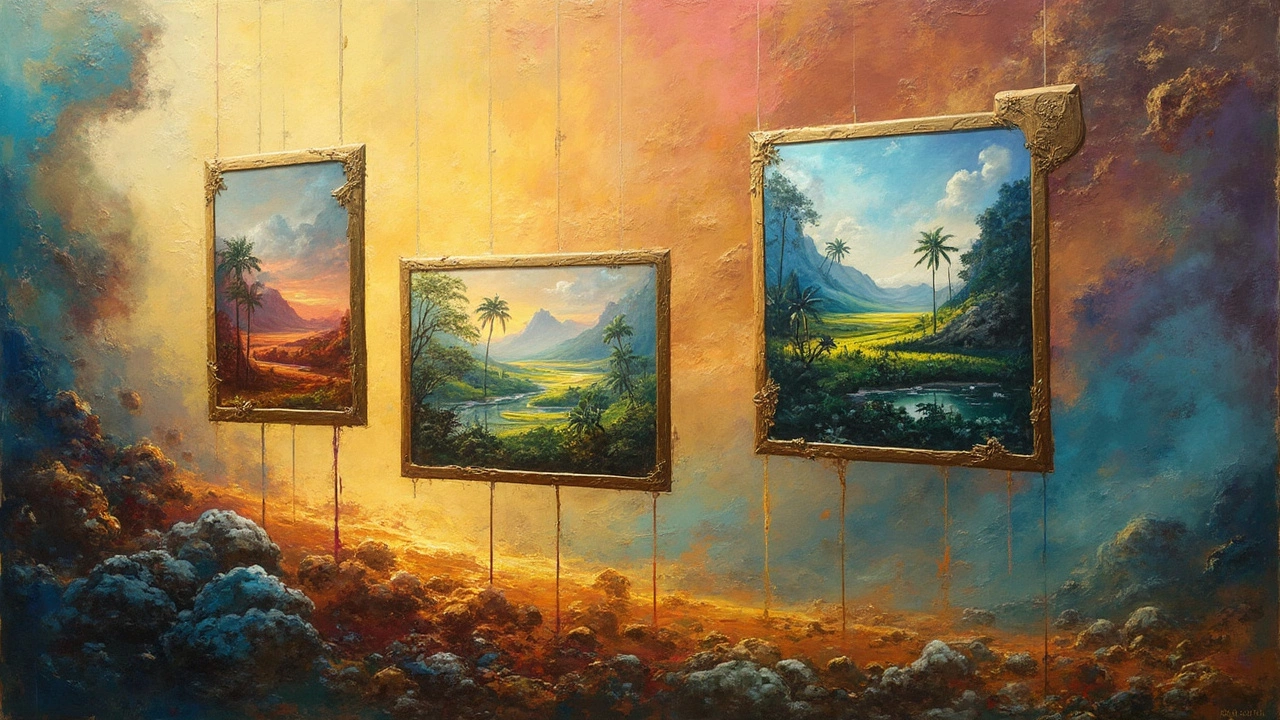
Techniques that Redefined Art
When it comes to modern landscape painting, Claude Monet's approach was nothing short of revolutionary. His techniques were daring and mixed the traditional with the avant-garde. Let's chat about what made his style so groundbreaking.
The Power of Light and Color
Monet was obsessed with capturing the changing effects of light. This might sound simple today, but back then, it broke new ground. Instead of using the expected, muted palette, he explored vibrant and dynamic colors. For instance, take a look at his series like "Haystacks" or "Water Lilies". Each painting in those series showcases the same scene at different times of the day, demonstrating how light and color transform perception.
Brushwork that Breathes
If you sneak up close to a Monet painting, you'd notice the brushstrokes are kind of loose and sketchy. He ditched detailed lines for dabs and swirls of paint, which brought a sense of movement and life. These strokes capture an impression of the scene rather than a photographic detail, linking directly to the essence of impressionism.
Plein Air Painting
Instead of painting indoors, Monet often painted outside, right there in nature. This approach, known as 'plein air' painting, helped him catch fleeting moments with authenticity. It wasn't just about sticking to one place; it was about immersing oneself in the environment and letting it influence the work in real-time.
Experimental Compositions
A lot of traditional art stuck to formal rules when it came to composition, but Monet wasn't afraid to play around. He often focused on unexpected angles or cropped views that gave the sense of a snapshot caught in time. This added a fresh perspective and anchored a sense of modernity to his art.
Monet's fearless experimentation didn't just influence his contemporaries—it paved the way for future generations. Today, his painting techniques serve as a masterclass in capturing the complex beauty of nature.
Influence on Future Generations
The ripples of Monet's impact on the art world were huge—a lot like when you drop a pebble into a pond. His approach to landscape painting didn't go unnoticed by fellow artists and those who followed. In fact, his way of seeing and interpreting nature changed the rulebook for art in so many ways.
Monet's inspiration wasn't just about his style; it was about a mindset of capturing immediate impressions, which heralded the birthplace of Impressionism. Young artists started experimenting with bright colors and loose strokes, breaking free from rigid academic standards. They sought to portray their own impression of a scene rather than a detailed, accurate reproduction.
Techniques Adopted by Future Artists
Many later painters, like Vincent van Gogh and Pierre-Auguste Renoir, took a page from Monet's book. They learned to interpret scenes with a vivid, impassioned approach, using bold colors and dynamic techniques. This shift in thinking about art paved the way for the modern art movements that we see today.
"Monet’s visual language provided a liberating break from the past. It gave artists the freedom to see and represent what truly resonated with them," said art historian James Thompson.
Monet’s influence wasn't just confined to painters in his region or era. As art became more global, his techniques were studied and revered by artists across the world. This competitive innovation led to new art schools and movements in the 20th century that emphasized personal expression.
The Lasting Legacy
Today, Monet's influence is still felt in studios and galleries. Art students are often encouraged to explore their unique interpretations rather than stick to traditional methods. His approach has passed the test of time, inspiring countless artists to push boundaries and view landscapes not just as static views, but as dynamic slices of life.
In a way, Monet didn’t just change painting—he changed how artists perceived the world. That’s a pretty incredible legacy for a guy who was just following his passion for landscapes.
| Artist | Movement |
|---|---|
| Claude Monet | Impressionism |
| Vincent van Gogh | Post-Impressionism |
| Pierre-Auguste Renoir | Impressionism |
Preserving the Legacy
The legacy of landscape painting and its transformation into its modern form is a journey that's still unfolding. As we appreciate art today, it's vital to understand how the seeds planted by pioneers like Monet continue to influence artists across the globe. Monet’s techniques might seem commonplace now, but they were revolutionary in their time.
One of the most significant ways his legacy is preserved is through art museums. Places like the Musée d'Orsay in Paris and the National Gallery in London host extensive collections of his work. They play a critical role not just in safeguarding these masterpieces but in educating the public about the evolution of modern art.
Conserving the Masterpieces
Conservation efforts ensure that Monet’s paintings stay as vibrant as he intended. Art restorers use the latest technology to maintain and restore these works, from cleaning to repairing damage. It’s a delicate balance of maintaining the original while ensuring it withstands the test of time.
Schools and Workshops
Another way Monet's legacy lives on is through education. Art schools and workshops across the world teach his methods. Budding artists study his brushwork, color use, and how he captured light. By learning his techniques, new generations of artists draw inspiration, creating their interpretations.
Digital Revolution
In our digital age, getting access to Monet’s works isn't limited to those who can travel to see them in person. Virtual tours and high-resolution images online bring this pivotal art into homes worldwide. This opens up a realm of possibilities for art lovers and students to experience his work intimately.
Preserving the spirit of these masterpieces goes beyond just hanging them on gallery walls. It’s about invigorating creativity, inspiring the new, and connecting the past with the present. With the continued focus on Monet’s techniques and the vibrancy of his work, the essence of modern landscape painting remains very much alive.
